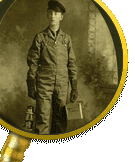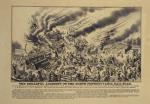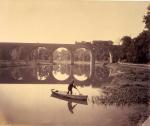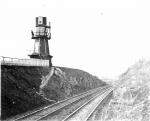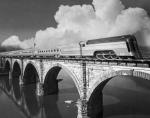Chapter Three: Technology - The Nuts and Bolts of Railroading
Railroad pioneers faced a series of daunting challenges. How could they push or pull loads of increasingly heavy weight on their tracks? What kind of track could best bear those great weights and increasing speeds? How were they to span rivers and gorges and cross high mountains? A body in motion tends to stay in motion. How were they to stop a train of many cars filled with tons of coal or steel hurtling along at fifty miles an hour? To each of these challenges, they found a solution; each solution, in turn, created new challenges.
In the 1830s, steam locomotives were a revolutionary breakthrough, but had only slightly more power than horses. By the end of the railroad era, however, locomotives were much faster and larger, and thousands of times more powerful. If the early locomotives seemed comparable indeed to "iron horses," later locomotives made the comparison between horseflesh and metal seem quaint.
The British-built Stourbridge Lion's rumble down the hemlock tracks of the Delaware and Hudson Canal Company in 1828 was the first locomotive trip in the Western Hemisphere. In the decades that followed, Pennsylvania became home to a wide range of steam-locomotive builders. In 1831, York foundryman
Stourbridge Lion's rumble down the hemlock tracks of the Delaware and Hudson Canal Company in 1828 was the first locomotive trip in the Western Hemisphere. In the decades that followed, Pennsylvania became home to a wide range of steam-locomotive builders. In 1831, York foundryman  Phineas Davis built America's first successful coal-fired locomotive.
Phineas Davis built America's first successful coal-fired locomotive.
In the 1850s, the Norris Locomotive Works of Philadelphia was the largest producer in America. In 1853, its 1,100 workers produced a hundred locomotives. Norris would soon be dwarfed by the Baldwin Locomotive Works of Philadelphia. The most prolific manufacturer of locomotives in American history, Baldwin built 76,000 locomotives over its 125-year history, most of them steam engines. Smaller locomotive builders elsewhere in the state built a wide variety of engines. Heisler of Erie and the
Baldwin Locomotive Works of Philadelphia. The most prolific manufacturer of locomotives in American history, Baldwin built 76,000 locomotives over its 125-year history, most of them steam engines. Smaller locomotive builders elsewhere in the state built a wide variety of engines. Heisler of Erie and the  Climax Manufacturing Co. of Corry both produced specialty engines for the logging industry. The Vulcan Iron Works of Wilkes-Barre and H.K. Porter Co. of Pittsburgh specialized in building smaller locomotives for industrial use.
Climax Manufacturing Co. of Corry both produced specialty engines for the logging industry. The Vulcan Iron Works of Wilkes-Barre and H.K. Porter Co. of Pittsburgh specialized in building smaller locomotives for industrial use.
In addition, the shops of the Pennsylvania, Philadelphia and Reading, Lackawanna, and Lehigh Valley railroads, like other builders, designed and built locomotives of increasing size and power. While early locomotives weighed as little as seven tons, by the time steam-engine production ended in the 1940s, the largest engines weighed 300 tons and generated nearly 8,000 horsepower.
Even the earliest locomotives were too heavy for the wooden and primitive iron tracks upon which they were supposed to run. Pennsylvanians met the challenge by manufacturing and using the first iron rails and soon afterwards the
first iron rails and soon afterwards the  first steel rails, which enabled manufacturers to build even larger, more powerful locomotives that hauled even longer and heavier trains behind them. This, in turn, heightened the problem of braking and the costly and deadly consequences of the failure to do so.
first steel rails, which enabled manufacturers to build even larger, more powerful locomotives that hauled even longer and heavier trains behind them. This, in turn, heightened the problem of braking and the costly and deadly consequences of the failure to do so.
Great train wrecks of the nineteenth century terrified and fascinated Americans, and cost railroads dearly. The problem of braking was finally solved by George Westinghouse, whose air brake, first patented in 1867, saved the lives of thousands of railroad brakemen, and enabled railroads to move heavier and faster trains more safely and with far fewer workers per train. Pennsylvania inventors and manufacturers also contributed mightily to improving the less-glamorous infrastructure that makes or breaks an operation. Among these fields were the development and production of signaling systems.
air brake, first patented in 1867, saved the lives of thousands of railroad brakemen, and enabled railroads to move heavier and faster trains more safely and with far fewer workers per train. Pennsylvania inventors and manufacturers also contributed mightily to improving the less-glamorous infrastructure that makes or breaks an operation. Among these fields were the development and production of signaling systems.
In terms of sheer labor and expense, no engineering feat was greater than the construction of the thousands of miles of railroad tracks that linked previously isolated regions into the national economic system sewn together by railroads.
To cross the state's sprawling mountain ranges, deep gorges, and wide rivers, Pennsylvania railroads constructed some of the engineering marvels of the nineteenth and early twentieth centuries. Pennsylvania boasted the nation's first railroad tunnel, and
first railroad tunnel, and  first iron railroad bridge,
first iron railroad bridge,  the world's highest railroad bridge, and the
the world's highest railroad bridge, and the  world's longest composite concrete and stone-arch bridge. It boasted the towering stone-arch
world's longest composite concrete and stone-arch bridge. It boasted the towering stone-arch  Starrucca Viaduct, and massive steel railroad bridges, including the Bessemer and Lake Erie Railroad's bridge over the Allegheny River near Oakmont, the Pittsburgh and Lake Erie Railroad's bridge over the Ohio River at Beaver, and the Pittsburgh and West Virginia Railway's (now Wheeling and Lake Erie) bridge over the Monongahela River at Belle Vernon. These marvelous feats of engineering, in the midst of the majestic landscapes, provided opportunities for artists such as Jasper Cropsey (in the 1860s) and photographers such as William H. Rau (in the 1890s) to define and redefine the image of the American railroad.
Starrucca Viaduct, and massive steel railroad bridges, including the Bessemer and Lake Erie Railroad's bridge over the Allegheny River near Oakmont, the Pittsburgh and Lake Erie Railroad's bridge over the Ohio River at Beaver, and the Pittsburgh and West Virginia Railway's (now Wheeling and Lake Erie) bridge over the Monongahela River at Belle Vernon. These marvelous feats of engineering, in the midst of the majestic landscapes, provided opportunities for artists such as Jasper Cropsey (in the 1860s) and photographers such as William H. Rau (in the 1890s) to define and redefine the image of the American railroad.
The master builders of Pennsylvania's railroads made skilled and innovative use of old and new materials. Reading's Skew Bridge demonstrates their skill at stone bridge building, and their pioneering use of concrete in the
Skew Bridge demonstrates their skill at stone bridge building, and their pioneering use of concrete in the  Tunkhannock Viaduct. Not all of their innovations were successes. In 1911, the Delaware, Lackawanna and Western Railroad built model worker housing out of the concrete that had proved so successful on its bridges and its retaining walls in suburban cuts. Within two decades, however, the houses of
Tunkhannock Viaduct. Not all of their innovations were successes. In 1911, the Delaware, Lackawanna and Western Railroad built model worker housing out of the concrete that had proved so successful on its bridges and its retaining walls in suburban cuts. Within two decades, however, the houses of  Concrete were so damp and cold they had to be abandoned.
Concrete were so damp and cold they had to be abandoned.
Railroads were complex economic enterprises that sprawled across great distances. They were massive purchasers and consumers of fuel, coal, steel and iron, rolling stock, wood, tools, machinery, and all of the food, furnishings, and other materials, large and small, necessary to provide for their millions of passengers. At its shops in Altoona, a city built by and for the railroad, the Pennsylvania Railroad (PRR) operated the nation's largest and best equipped product testing lab. There, beginning in the 1870s, its engineers tested everything from oranges, gloves, and broom handles to massive 250-hundred-ton locomotives, which they ran on stationary rollers at speeds as high as 100 miles per hour to evaluate thermal efficiency, fuel and water consumption, power output, characteristics of different grades of coal, and other performance measures.
shops in Altoona, a city built by and for the railroad, the Pennsylvania Railroad (PRR) operated the nation's largest and best equipped product testing lab. There, beginning in the 1870s, its engineers tested everything from oranges, gloves, and broom handles to massive 250-hundred-ton locomotives, which they ran on stationary rollers at speeds as high as 100 miles per hour to evaluate thermal efficiency, fuel and water consumption, power output, characteristics of different grades of coal, and other performance measures.
Because of its early role as a cradle of American railroading, Pennsylvania grew into a railroad workshop that was capable of inventing and refining everything needed for successful railroading, from steel rails to signals to complete locomotives. With its many railroads, the state attracted and nurtured a railroad-supply manufacturing sector that was constantly probing the technological limits of science for new developments that could make the industry more efficient, more profitable, and safer.
Pennsylvania also developed a huge industry in commercially manufacturing cars for railroads nationwide. Near Meadsville, the Densmore brothers built the nation's first oil tank cars in 1865. Freight cars were built by the American Car and Foundry Co. of Berwick and Milton; Greenville Steel Car Co. of Greenville; Bethlehem Steel Corp. of Johnstown; Pullman-Standard, Inc. of Butler; and Pressed Steel Car Co. of McKees Rocks, site of the infamous
first oil tank cars in 1865. Freight cars were built by the American Car and Foundry Co. of Berwick and Milton; Greenville Steel Car Co. of Greenville; Bethlehem Steel Corp. of Johnstown; Pullman-Standard, Inc. of Butler; and Pressed Steel Car Co. of McKees Rocks, site of the infamous  McKees Rocks strike. Some of these firms, notably ACF and Pressed Steel Car, also built passenger cars.
McKees Rocks strike. Some of these firms, notably ACF and Pressed Steel Car, also built passenger cars.
Most railroads also maintained shops that repaired cars, and many of those company-owned shops built new freight cars as well. The Budd Co. of Philadelphia became a national leader in building streamlined passenger cars from the 1930s through the 1950s, using patented techniques to create gleaming stainless-steel trains. Among them were the Santa Fe Railway's Super Chief (Chicago-Los Angeles), the Reading's Crusader (Philadelphia-New York), and the PRR's Congressional (New York-Washington).
In the twentieth century, Pennsylvania's railroads were among the first to experiment with electric power for propulsion. The Cumberland Valley Railroad electrified its eight-mile Mechanicsburg-to-Dillsburg run in 1906, placing traction motors on the axles of two wooden coaches and designating other coaches as trailers to be pulled by these units. The PRR began electrification of its commuter operations when it wired the Paoli Local in 1914. The Reading Railroad electrified its Philadelphia commuter lines in 1931. Both of these systems were cleaner, cheaper, and easier to operate than with steam power, and both survive today under the Southeastern Pennsylvania Transportation Authority, providing service to tens of thousands of passengers every day.Electrification of all of its East Coast main lines enabled the PRR to handle the tremendously heavy loads of World War II.
Cumberland Valley Railroad electrified its eight-mile Mechanicsburg-to-Dillsburg run in 1906, placing traction motors on the axles of two wooden coaches and designating other coaches as trailers to be pulled by these units. The PRR began electrification of its commuter operations when it wired the Paoli Local in 1914. The Reading Railroad electrified its Philadelphia commuter lines in 1931. Both of these systems were cleaner, cheaper, and easier to operate than with steam power, and both survive today under the Southeastern Pennsylvania Transportation Authority, providing service to tens of thousands of passengers every day.Electrification of all of its East Coast main lines enabled the PRR to handle the tremendously heavy loads of World War II.
In the 1900s, Pennsylvania locomotive manufacturers, however, were late to switch to the production of electric and diesel locomotives. Baldwin dabbled in electric power, but as the nation's dominant steam-engine builder, its corporate culture was heavily invested in that earlier technology. So its line of diesel locomotives was introduced late and did not succeed against the better-engineered products of General Motors Corporation. Unable to catch up, Baldwin exited the locomotive business in 1956.
In the 1830s, steam locomotives were a revolutionary breakthrough, but had only slightly more power than horses. By the end of the railroad era, however, locomotives were much faster and larger, and thousands of times more powerful. If the early locomotives seemed comparable indeed to "iron horses," later locomotives made the comparison between horseflesh and metal seem quaint.
The British-built
In the 1850s, the Norris Locomotive Works of Philadelphia was the largest producer in America. In 1853, its 1,100 workers produced a hundred locomotives. Norris would soon be dwarfed by the
In addition, the shops of the Pennsylvania, Philadelphia and Reading, Lackawanna, and Lehigh Valley railroads, like other builders, designed and built locomotives of increasing size and power. While early locomotives weighed as little as seven tons, by the time steam-engine production ended in the 1940s, the largest engines weighed 300 tons and generated nearly 8,000 horsepower.
Even the earliest locomotives were too heavy for the wooden and primitive iron tracks upon which they were supposed to run. Pennsylvanians met the challenge by manufacturing and using the
Great train wrecks of the nineteenth century terrified and fascinated Americans, and cost railroads dearly. The problem of braking was finally solved by George Westinghouse, whose
In terms of sheer labor and expense, no engineering feat was greater than the construction of the thousands of miles of railroad tracks that linked previously isolated regions into the national economic system sewn together by railroads.
To cross the state's sprawling mountain ranges, deep gorges, and wide rivers, Pennsylvania railroads constructed some of the engineering marvels of the nineteenth and early twentieth centuries. Pennsylvania boasted the nation's
The master builders of Pennsylvania's railroads made skilled and innovative use of old and new materials. Reading's
Railroads were complex economic enterprises that sprawled across great distances. They were massive purchasers and consumers of fuel, coal, steel and iron, rolling stock, wood, tools, machinery, and all of the food, furnishings, and other materials, large and small, necessary to provide for their millions of passengers. At its
Because of its early role as a cradle of American railroading, Pennsylvania grew into a railroad workshop that was capable of inventing and refining everything needed for successful railroading, from steel rails to signals to complete locomotives. With its many railroads, the state attracted and nurtured a railroad-supply manufacturing sector that was constantly probing the technological limits of science for new developments that could make the industry more efficient, more profitable, and safer.
Pennsylvania also developed a huge industry in commercially manufacturing cars for railroads nationwide. Near Meadsville, the Densmore brothers built the nation's
Most railroads also maintained shops that repaired cars, and many of those company-owned shops built new freight cars as well. The Budd Co. of Philadelphia became a national leader in building streamlined passenger cars from the 1930s through the 1950s, using patented techniques to create gleaming stainless-steel trains. Among them were the Santa Fe Railway's Super Chief (Chicago-Los Angeles), the Reading's Crusader (Philadelphia-New York), and the PRR's Congressional (New York-Washington).
In the twentieth century, Pennsylvania's railroads were among the first to experiment with electric power for propulsion. The
In the 1900s, Pennsylvania locomotive manufacturers, however, were late to switch to the production of electric and diesel locomotives. Baldwin dabbled in electric power, but as the nation's dominant steam-engine builder, its corporate culture was heavily invested in that earlier technology. So its line of diesel locomotives was introduced late and did not succeed against the better-engineered products of General Motors Corporation. Unable to catch up, Baldwin exited the locomotive business in 1956.


